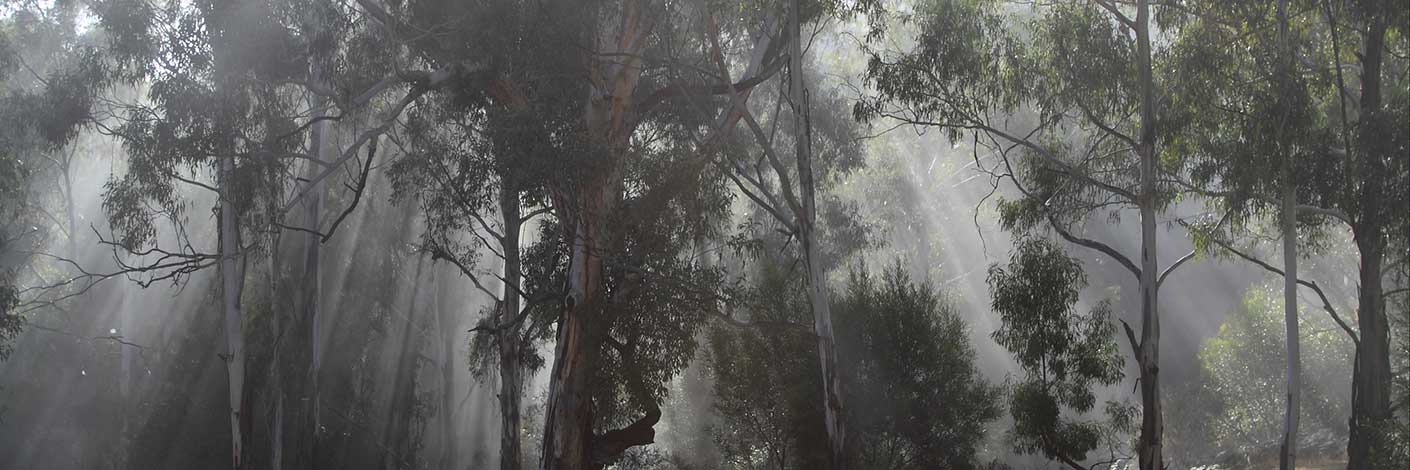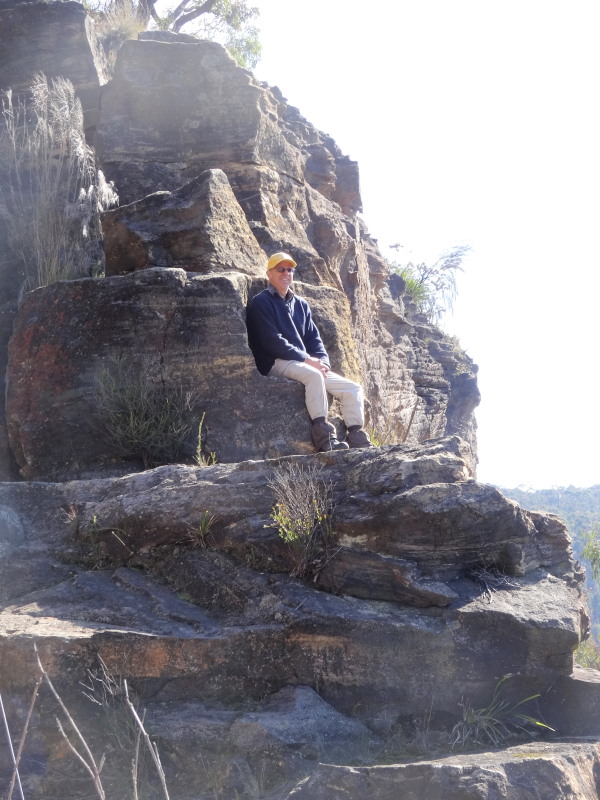Bush Explorers Encyclopaedia
Wheat Paddock
Is an old local usage name referring to Sunnyside Ridge in the vicinity of Birds Rock Trig Station. So named as the trees were tall, thin and closely spaced together, likened to wheat in a paddock. Name in use in the 1940s. Ref: Correspondence with Joe Bird, 6th February 2010, whose father Jim cut logs in this area.
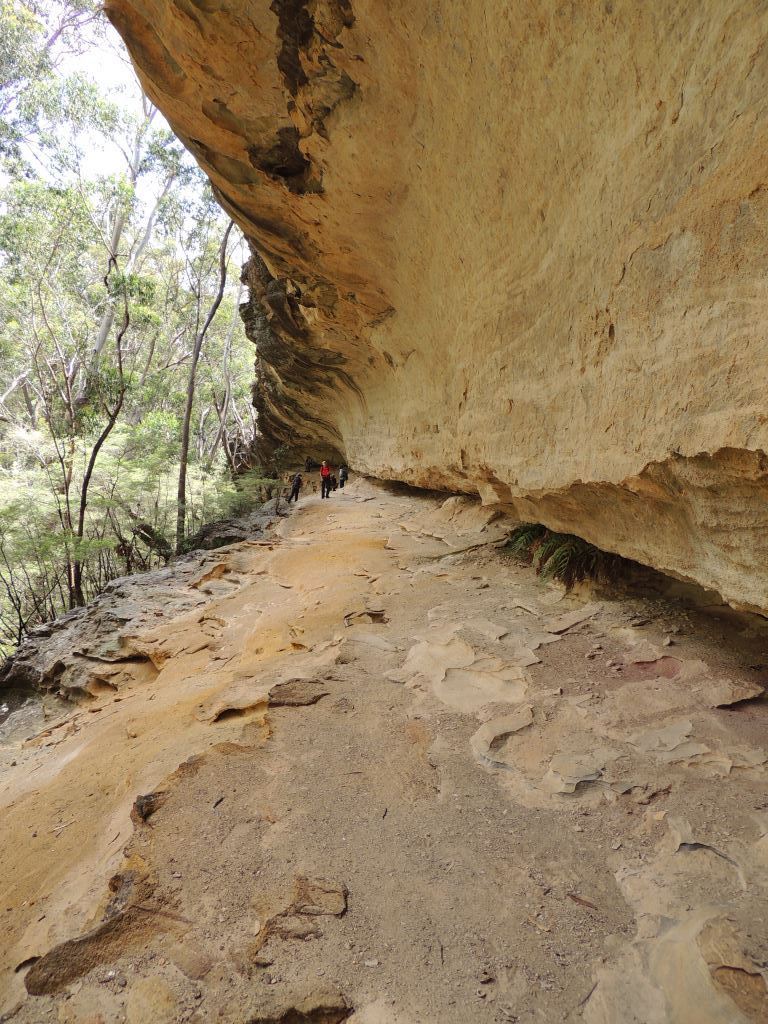
Whispering Gallery
Is located 100m north east of the locked gate on the Pagoda Track and 700m north east of the Glowworm Tunnel, Newnes Plateau. This 85m long overhang has a dry elevated floor and its southern extremity features an almost spherical cavern. In the centre is a small string waterfall that drops down from a slotted keyhole in the domed roof. Quite by accident, it was discovered that this is a whispering wall, so a quietly spoken comment at one end can be clearly heard at the other. Named by Michael Keats and Brian Fox on a Bush Club walk, 2nd January 2017.
White Gate Trail
Is a 4WD track, 2.4km in length. It joins Castlereagh Highway 2.8km south of Ben Bullen and Moffitts Trail. The majority of the southern part of this trail is on private property.
Whitewash Cave
Is a cave that was used by the Aboriginal people, 8m wide, 5m depth and 8m high. It is located on the eastern side and near the top of the hill above Cullen Bullen township. So named by the locals as they carried back the white ochre to white wash their houses. Ref: Elaine (Lucy) Devigne, oral history recorded 20th September 2012, she recalled her father doing just that, he had known this cave by its name from 1947. At present, there is no evidence of Aboriginal usage.
Wild Gorge
Has within it the features Dome Cave, Pinch Point Circle and is overlooked by Tagine Point. Its headwaters are 2km south, south east of Birds Rock Trig. It flows generally in an eastward direction for 1.9km to its junction with Carne Creek. Named by Yuri Bolotin, 16th May 2013.
Wild Slots
Comprises three slots on the eastern side of Deception Canyon, 700m west, north west of of the Glowworm Tunnel car park. It appears as that there is no walking access to the canyon floor. There appears to be a very large overhang under the southern wall. Named by Yuri Bolotin on a Bush Club walk, 10th January 2014.
Wiltons Ridge
Is a spur line that trends in a north south direction from midway between Hartley Trig and Browns Gap to Braceys Lookout having the road Norm Henry Drive along its spine. Named after Thomas Talbot Wilton (1834-1911). General Manager of the Lithgow Valley Colliery 1872-1911. Wilton also owned land in this area. Ref: Democrat 7th August 1915, p. 13. Lithgow Mercury, 8th October 1915, p. 6.
Winding Pinch Creek *
Is a non perennial creek rising on the southern side of Glen Davis Road 4km south east of Mount Airly. It flows generally south east and south, south west for about 4km into Airly Creek. This was either a name relating to the mining era (winding up a bucket of ore), or it may be a descriptive name given to a narrow pinch of land (ridge line) which was needed to access this isolated 40ac parcel of land applied for by Murray Davidson on the 20th February 1879. Ref: Survey Plan 1674.1496. Shown on the map Parish of Coco, County of Roxburgh, 1883.
Window in the Sky Ravine
Is a 2.6km non perennial watercourse that has its headwaters 1.1km north east of Birds Rock Trig and flows north, north east into Carne Creek. At the point where this creek flows over the cliff line, the rock formation is likened to a window frame about 50m below the top of the cliff line and about 150m above the base of the cliffs below. This name was coined by Brian Fox and Michael Keats on a Bush Club walk, 10th October 2013.
Window to Infinity
Is a cliff top window view looking down a 50m vertical drop. Located 1.1km south east of Beecroft Trig Station. Named by Brian Fox on a Bush Club walk, 30th May 2014. Brian's immediate thought was that it gave the similarity to an infinity pool.
Window to Oblivion
Is a balcony window view looking down a 50m vertical drop. Named by Daryl Watson on a Bush Club walk, 11th April 2014. Located 1.6km north west of road junctions, Angus Place Trail and Beecroft Firetrail.
Windy Gully
Is a narrow, north west facing, cliff lined section of unnamed creek which flows into Rocky Creek 3.5km north west of Mount Cameron. Ref: Correspondence with Danny Whitty, 3rd July 2010.
Witches Mouth
Is the exit from The Dungeon as it involves a crawl through a tunnel that discharges into a dry gully. Named by Yuri Bolotin 29th August 2015.
Witches Vice
Witches Watch
Is a lookout overlooking Hecates Cauldron above Pandoras Ravine. Named by Yuri in keeping with the Macbeth inspired naming theme. Peculiarly shaped shards of ironstone including a natural collar are regarded as witches" accoutrements.
Witches Yale
Is a mythical beast and this natural rocky gargoyle framed against the sky as viewed from below Tara Slot is within Hecates Cauldron. Named by Michael Keats on a Bush Club walk, 25th September 2015.
Wobbegong Rock
Is located on the spine of the Wolgan – Capertee Divide, between Mount McLean and Mount Jamison. So named by Brian Fox on a Bush Club walk, 30th September 2013 as the rock resembles a Wobbegong Shark.
Wolgan *
Is now referred to by the Geographical Names Board as a, "Rural Place". It is located in the vicinity of the old Wolgan Homestead and present Emirates Wolgan Valley Resort. The planned Village of Wolgan was located on the level ground, southern side of Wolgan Road and western side of Mount Wolgan. Ben Bullen Topo Map, GR 359 186. At Wolgan, two acres were set aside for a public school on 20th September 1871. Ref: Survey Plan 143-1978. A church, manse and cemetery were approved on 9th February 1874. Ref: Survey Plan372-1984. Adjoining this area to the south was an area reserved for residential or business purposes, 8th February 1894. Wolgan was the chosen Aboriginal name of James Walker's outstation (homestead), c1825. It was this name which gave Wolgan Valley its name. Ref: Survey Plan B4.691r, dated 3rd January 1831. Stevens, Wade. Wolgan Valley Selected Climbing Areas, 2001, p. 37. Records,"reportedly the native name for its site at the confluence of the Wolgan River and Carne Creek ." Also see Mount Wolgan.
According to Isabella Gertrude (Gert) Poyitt, who was a school teacher in the Wolgan Valley in the 1920’s the name Wolgan came from the local aboriginal word, ‘wolga’, the name for the Australian Clematis,Clematis aristata, a vine that is fairly common in the valley.
Helen Riley, Wiradjuri Elder and Sharon Riley, Wiradjuri representative, also record the word Wolgan, is named after the native plant Clematis aristate. Ref: Oral history 3rd May 2016.
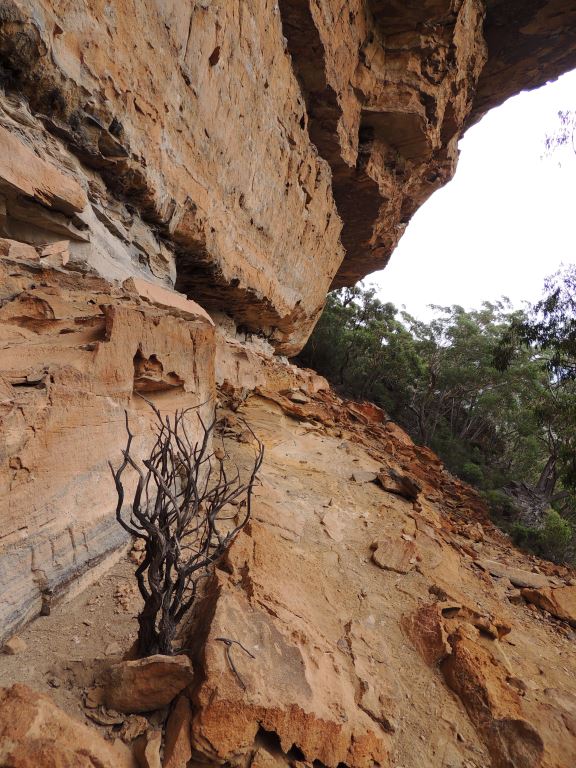
Wolgan Balcony
Is a 1km ledge between two cliff lines above the Wolgan River and above the Wolgan Valley railway alignment, 1.1km north, north west of the Glowworm Tunnel. The ledge offers extensive views of the Wolgan Valley and Donkey Mountain. Named on a Bush Club Walk by Michael Keats, Yuri Bolotin and Brian Fox, 27th January 2017.
Wolgan Falls
Mark the western end of the tight, winding canyon of the Wolgan River, as the waterfall flows over the cliff line into what is the start of the Wolgan Valley. Wolgan Falls are accessed via Blackfellows Hand Trail and Fire Trail No. 5 from the western side, or Fire Trail No. 7 from near the road junction of Sunnyside Ridge Road and Fire Trail No. 8 on the northern side. Best view of falls, GR 346 103.
Wolgan Gap
See entry Woolpack Gap. Wolgan Gap was the previous name.
Wolgan Gap Ref: Parish of Wolgan 1905, 3rd ed; 1916, 4th; 1930, 5th editions and Carnes Geological Map Capertee and Wolgan Valley, 1901. It was not until the Ben Bullen Topo Map of 1974 that Woolpack Gap is shown and gazetted by the Geographical Names Board 20th June 1975. It quite obviously was renamed to avoid confusion with Wolgan Gap on the Wolgan Road as the entrance to the valley.
Wolgan Gap *
Is the break in the cliff line that provides road access to Newnes from Lidsdale. Before the present road descended down Wolgan Gap, the road was on the eastern side of this gap and that path was called Donkey Steps. It was used to bring in the first cattle prior to 1880. Ref: Joe Bird, past resident of the Wolgan Valley, oral history to Brian Fox, 17th June 2009. Survey Plan R587.1603r, dated 3rd March 1866. The Survey Plan 6-2062, dated October 1874, shows the road through "The Gap." The name Wolgan Gap is shown on the map Parish of Cox, 1884. The Sydney Morning Herald,14th July 1877, p. 3, records, "Road grant at Wolgan Gap, 250 pounds."
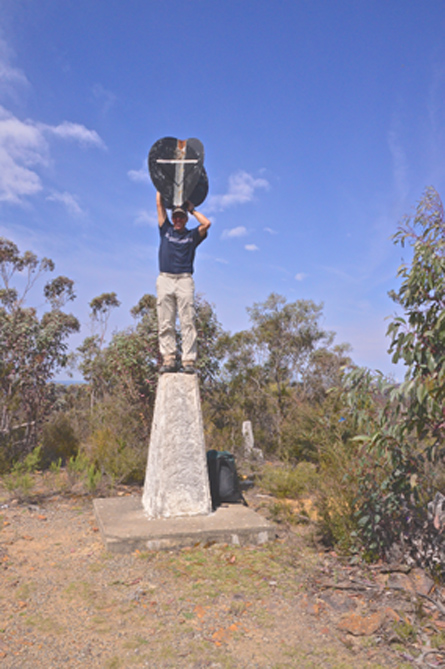
Wolgan Gap Trig Station *
Height of 1078m, is located 1.5km near north of Wolgan Gap. Wolgan Gap Trig Station was established in October 1930 by Warrant Officer Hugh Powel Gough Clews, a surveyor from the Royal Australian Survey Corps.
Wolgan Gorge Lookout
Is located on top of the cliff line overlooking the Wolgan River and canyon, accessed via Fire Trail No. 5 off Blackfellows Hand Trail. Karen McLaughlin from the Blue Mountains Conservation Society recorded,"We named the lookout Gorge because for inexperienced bushwalkers it is a bit of a scramble to get a full view of the falls where as you can easily get magnificent views of the gorge." Ref: Correspondence from Karen on 30th November 2009. Shown on the map Proposed Recreation Use; Wolgan SF, Ben Bullen SF, Newnes Plateau. Gardens of Stone Stage 2 Reserve Proposal. The Blue Mountains Conservation Society and Colong Foundation for Wilderness, January 2009.
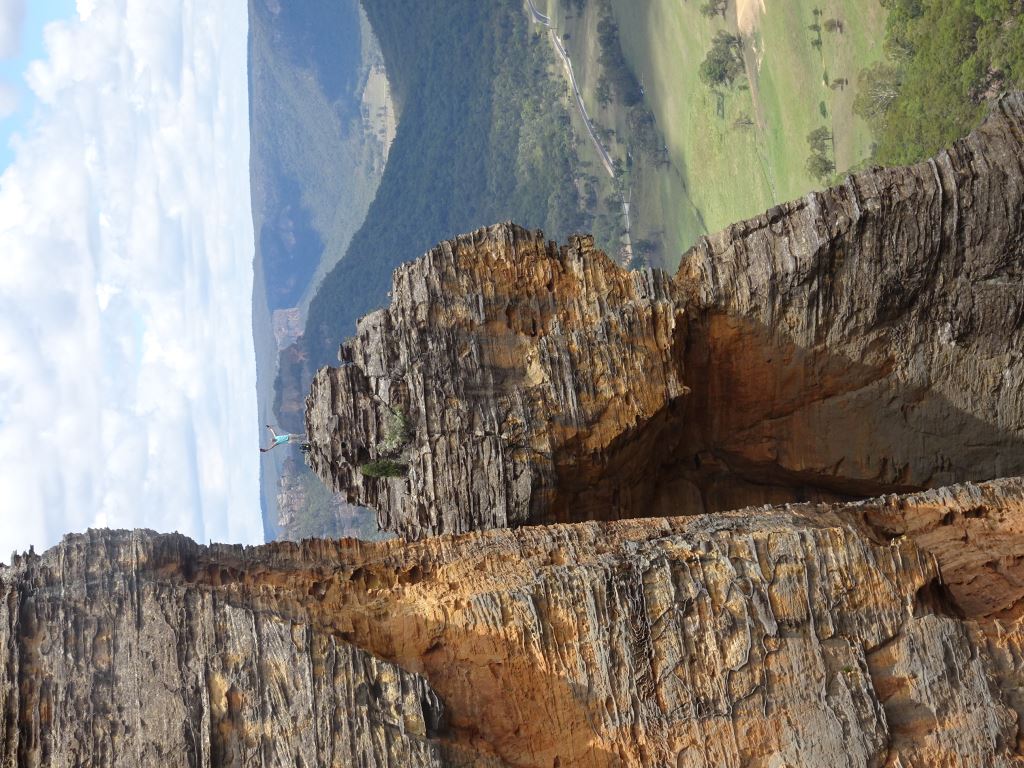
Wolgan Guardian
Is located on a western facing cliff line, 2.2km south, south east of Mount Dawson and 1.5km north, north east of thePenrose.This massive 110m high eroded residual is 30m below the top of the cliff line and the top 45m of this pinnacle is separated from the main cliff line by one to five metres. The views from this guardian rock give a line of sight right up the valley floor. Named by Yuri Bolotin and Brian Fox on a bush walk 6th January 2017.
Wolgan Loops
Are five compressed loops in a deep incised gorge, located immediately before the Wolgan River (Wolgan Falls) plunges over the cliff edge. Named by Michael Keats on a Bush Club walk, 9th January 2008.
Wolgan Panorama
Wolgan Panorama
Is a viewing point on the southern end of a spur line south west of Mount Tricky and 800m north, north west of Little Capertee Camping Ground, Newnes. Located 300m above the Wolgan River this spot gives unprecedented openness of the panorama in front of you; and, secondly, it is the angle of viewing, as you look straight down the main, broad section of the Wolgan Valley and the expansive area where the river makes a 90 degree bend to the east. Named by Yuri Bolotin and Brian Fox on a Bush Club walk 28 August 2017.
Wolgan Pass
Is located 800m due north of Wolgan View Lookout. This north south facing gully allows access from the western side of the Wolgan cliff line. Named by Michael Keats on a Bush Club walk, 16th February 2015.
Wolgan Pillars
Refers to huge hanging rock formations over 100m high, having outward curved as well as straight sides and just enough distance from the main rock face to be called Pillars. Located on the southern side of the Wolgan River, 2km north west of the junction with Annie Rowan Creek. So named by the rock climbing fraternity.
Wolgan Pinnacle *
Is located on top of the cliff line, 4.5km west, north west of Deanes Siding. Access via Sunnyside Ridge Road and Fire Trail No. 7.
Wolgan Pinnacle Slot
Is a natural pass on the northern side of Wolgan Pinnacle giving challenging access down to Carne Creek. The name was suggested by Michael Keats on his Bush Club walk, 27th December 2006. It is derived from the overpowering Wolgan Pinnacle nearby.
Wolgan River *
Is a watercourse about 64km long. It rises on the Blue Mountains Range 4.5km north west of Bungleboori and flows in a generally northerly direction towards Newnes, where it turns eastward to its junction with the Capertee River. Lithgow. The Wolgan River and Carne Creek join at the southern edge of the Ben Bullen Topo Map, GR 387 177. Previously, these two major drainage patterns were known as the Eastern and Western Branches of the Wolgan River. The Eastern Branch was renamed Carne Creek in 1970. Ref: Geographical Names Board notes, 5th March 1970. Shown as Wolgan River Western Branch and Wolgan River Eastern Branch on the map Parish of Wolgan, 1884. Surveyor Frederick Robert D'Arcy surveyed the Wolgan River from near present day Newnes downstream towards the junction with the Capertee River, July 1831. Ref: Surveyor General Letters received from surveyors, Reel No. 3060, Andrews, Alan E J. Major Mitchell's Map, 1834.
Wolgan River Trail
Starts at the locked gate on the southern side of the Wolgan River 1.2km south, south east of Newnes. It follows the Wolgan River for about 14km. This track was the original access to the holdings at Binnings Hole at the junction of Annie Rowan Creek.
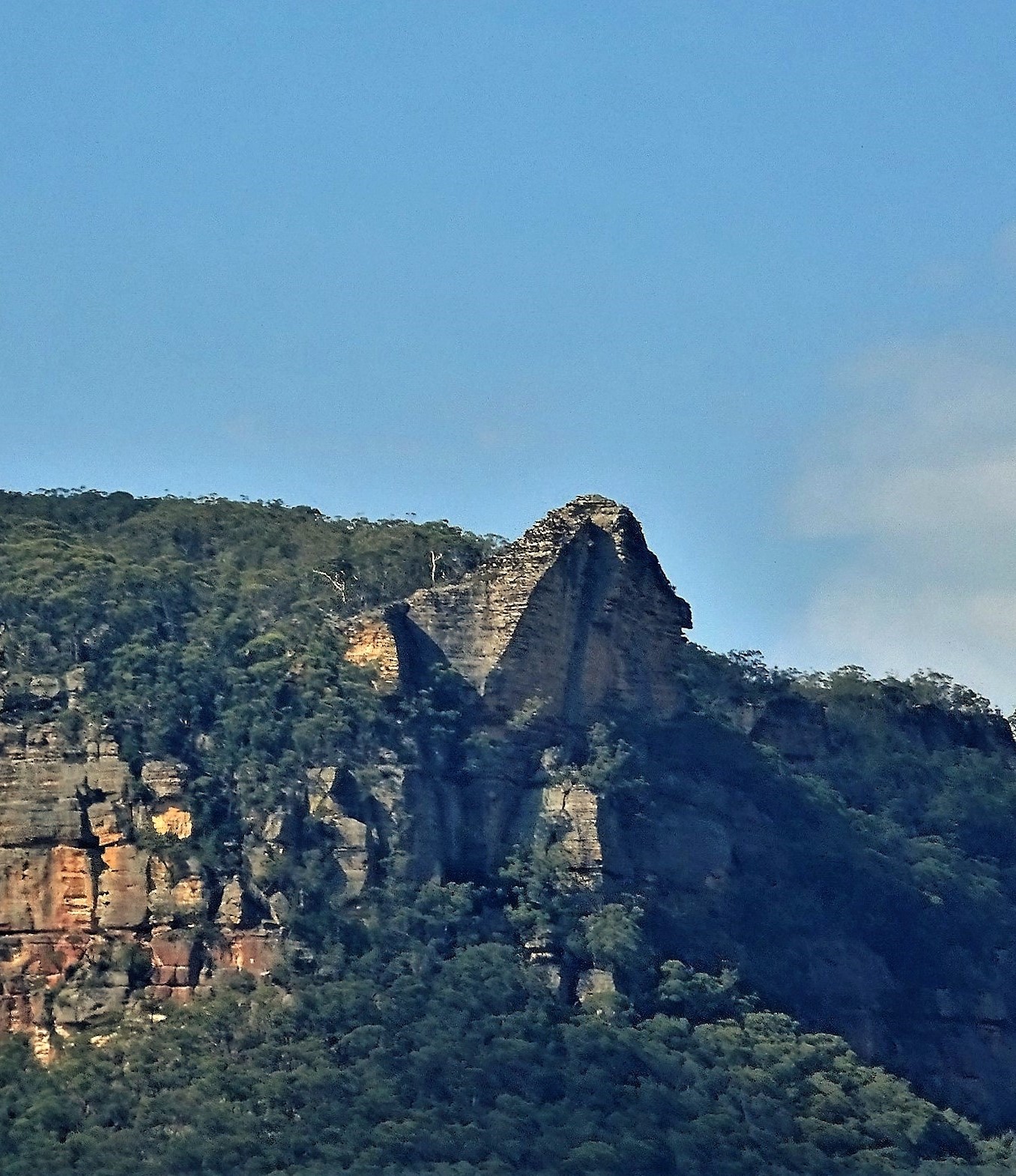
Wolgan Rock
Is a most impressive buttress. When viewed from the Newnes side whilst driving the Wolgan Valley Road this rock juts out and dominates the cliff line. Located 900m south east of Collett Gap. Named by Yuri Bolotin on a Bush Club Walk 15th August 2016.
Local resident of Wolgan Valley, David Stafford records, “What you call Wolgan Rock we have always called The Sphinx due to its Sphinx like profile when viewed in certain light from the west (ie from our house).”
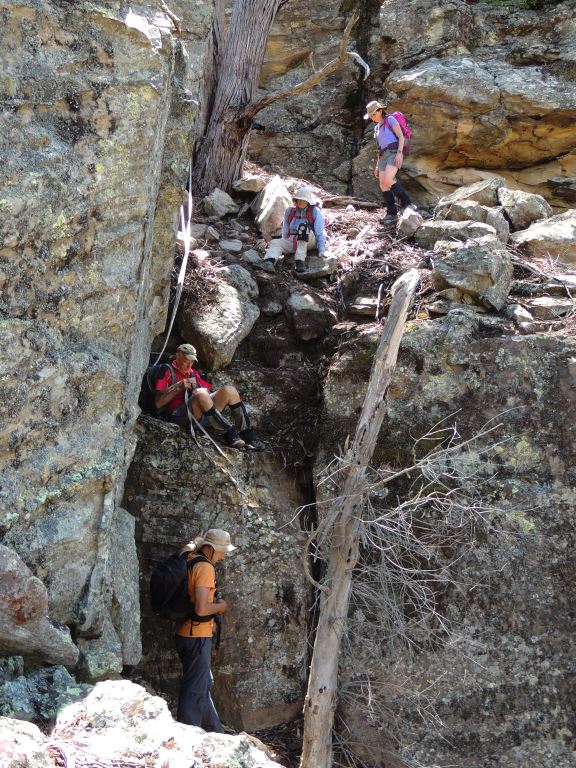
Wolgan Rock Pass
Gives walking access to Wolgan Rock, a significant geographical feature, from Wolgan Road opposite Donkey Mountain and 1.2km south east of Collett Gap to the Wolgan / Capertee Divide. Named by Yuri Bolotin and Brian Fox on a bush walk 16th January 2017.
Wolgan State Forest *
Was Notified on the 25th May 1896. Located in the southern part of the Wolgan Valley below the cliff line; it covers an area of about 1200ha.
Wolgan Trig Station *
Is located on Mount Davidson, the highest point of the Wolgan - Capertee Divide, 1081m. Constructed on 8th April 1914. At present, it lays in ruins. Ref: Survey Plan 1508-3090.
Wolgan Valley *
Is an enclosed valley that has only one road access via Lidsdale and Wolgan Gap. It was Campbell Mitchell, son of Sir Thomas Mitchell, who was the first to discover kerosene shale deposits in the Wolgan Valley and open up a mine in 1873. Ref: Carne, Joseph. The Kerosene Shale Deposits of New South Wales, 1903, p. 38.
Wolgan Valley Railway
Branched from the Main Western Line at Newnes Junction, GR 443 930, and terminated at Newnes, GR 424 258. Construction of the Wolgan Valley Railway of some 31 miles 50 chains (51km) from Clarence on the Great Western Railway line to Newnes commenced in November 1906 and was effectively completed in November 1907. The line ceased carrying rail traffic in 1937. Ref: Hicks, George and O'Brien, Dennis. Shays in the Valley. According to Bentley, James. Black Smoke. Blue Mountains, 1988, p. 77, the line finally closed in 1932. This private railway line was built to carry oil, wax, sulphate of ammonia, coke and other various products from the Commonwealth Oil Corporation's shale mine and refinery at Newnes to where it joined the Main Western Line at Newnes Junction. From here, products went on their way to Sydney or, in the case of the coke, to the Lithgow blast furnace. Ref: Bentley, James. Black Smoke. Blue Mountains and McKillop, Bob. Furnace, Fire and Forge, 2006, pp. 204-205.
Wolgan View Lookout
Wolgan View Point
Wollangambe
Is an Aboriginal word, the meaning unknown. It was first recorded on Surveyor General Sir Thomas Mitchell's Map of the Colony of New South Wales, 1834.
Wollangambe Crater *
Is an amphitheatre 7km east of Newnes Junction on the northern side of Wollangambe River. Previously known as The Crater. Ref: Geographical Names Board records, 5th March 1975. Crater is a mismoner. The structure is not an impact crater at all. It is a closed loop or anabranch of the Wollangambe River.
Wollangambe River *
Is a watercourse approximately 50km long. It rises about 1km south east of Happy Valley Springs and flows generally east then north, north east into the Colo River.
Wollemi National Park *
Is part of the Greater Blue Mountains. It is roughly bounded on the east by the Putty Road, to the south by the Bells Line of Road, while the western boundary adjoins the Gardens of Stone National Park and the northern boundary adjoins the Goulburn River National Park. Our area of interest is covered by the Topo Maps Wollangambe, Rock Hill, Mount Morgan, Cullen Bullen and Ben Bullen. Wollemi National Park is over 487,000 hectares, making it the second largest park in NSW behind Kosciuszko. Located about 150km north west of Sydney. It was created in December 1979 and listed as part of the Greater Blue Mountains World Heritage Area in December 2000. The park contains the largest remaining area of wilderness in NSW. The Wollemi Pine,Wollemia nobili, was named after the area in which it was found and after the person who first found it, David Noble. The Wollemi Pine was first seen and leaf samples collected by David Noble in June 1994. At the time, David was a National Parks and Wildlife Service field officer. Ref: Woodford, James. The Wollemi Pine, 2000, pp.10-14. Wollemi is believed to come from the Darkinung word wollumnii, which means "lookaround you" or "watch your step" Ref: Woodford, James. The Wollemi Pine, 2000, p. 5. Wollemi, Wallambine, Wollombi (a.k.a. Wolombi or Wallumbi) and more are variations of the same Aboriginal expressions and could have been the original tribal term for the people or the country of the Hawkesbury Hunter Ranges. Ford, Geoff E. Darkinung Recognition, Masters Thesis, 2010, p. 77. Also, "The general word Wollemi, Wollombi and Wallambine [a wide range of spellings] was an oral term used by Darkinung Language Aborigines for county of the northern Blue Mountains", Op. cit. p. 424.
Wombat Gully
Gives access from one of the many tributaries of Cullen Creek to the top of the cliff line. Located 530m near due north of Invincible Trig Station. Named by Yuri Bolotin on a Bush Club walk, 30th August 2103, due to close sighting of a large Wombat within the gully nearby.
Wonder Pass
Is so named, as on the Cullen Bullen Topo Map the cliff line on the eastern side of Carne Creek via Fire Trail No. 6 off Glowworm Tunnel Road, shows 162m relative height of the cliff line. So Yuri Bolotin on the Bush Club walk, 28th April 2014 "wondered" whether there would be a walking access. The reality was that there is no cliff, in its place is a steep grade talus slope that can be climbed easily all the way to the top that coincides with the 1000m contour.
Woolpack Gap *
Is a saddle in the mesa east of Woolpack Rock. It is 2.3km east of Wolgan Trig Station. To the north is the drainage for Red Rock Creek in the Capertee Valley. To the south is the drainage which flows into Barton Creek in the Wolgan Valley.
The name Woolpack Gap was called Wolgan Gap Ref: Parish of Wolgan 1905, 3rd ed; 1916, 4th; 1930, 5th editions and Carnes Geological Map Capertee and Wolgan Valley, 1901. It was not until the Ben Bullen Topo Map of 1974 that Woolpack Gap is shown. Gazetted by the Geographical Names Board 20th June 1975. It quite obviously was renamed to avoid confusion with the name Wolgan Gap on the Wolgan Road at the entrance to the valley.
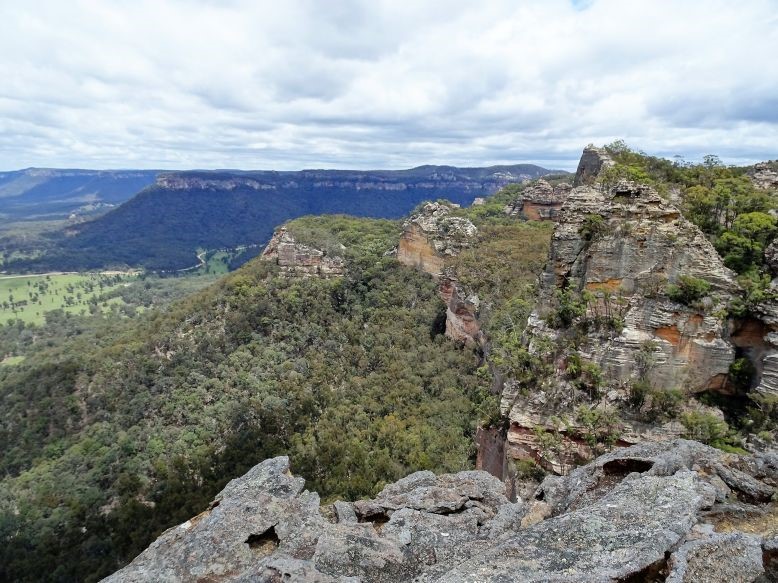
Woolpack Point
Is located on the northern escarpment of the Wolgan Valley and faces the eastern side of Woolpack Gap. Dramatic views of Woolpack Rock. Wide extensive views of the Wolgan Valley from Cape Horn and Aclatraz in the south west to the mesa of Donkey Mountain towards the south east. Named by Yuri Bolotin on a bushwalk on 23 November 2018.
Woolpack Rock *
Is a rock formation in the mesa 2.2km east of Mount Davidson and Wolgan Trig Station. Named by Surveyor John Byrne Richards and shown on his Survey Plan, 3rd January 1831 as The wool-pack-rock. Ref: Survey Plan B4-691r. In early editions of the Parish of Wolgan, shown as Woolpack Rock. This name and the name Wolgan are the first names recorded by Europeans in the Wolgan Valley. Described by Michael Keats, 4th September 2009, as, " Woolpack Rocks, looking like 4 huge woolbales, batched together."
Yahoo Ridge
Extends 2.3km from Natural Bridge on Mount Cameron Trail in a generally north east direction to above Nayook Creek. So named after the Yah Hut, which lies in ruins at the eastern end of this ridge. Name recorded in the Yah Hut Log Book entry, 12th November 1972.
Y Canyon
Is the south west arm of a deeply incised feature that drains water from the Mount Budgary Plateau into Budgary Creek. The top end is located at GR 489 114 and the junction of the two branches of the "Y" Canyon is at GR 489 115. Named by Michael Keats on a Bush Club walk, 28th December 2007.
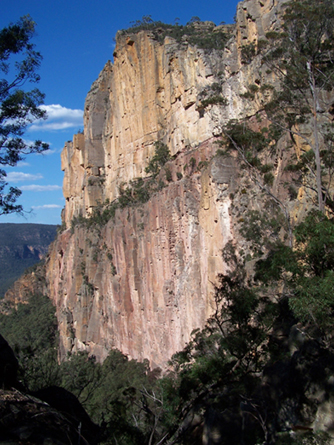
Yerra Yerra Pass
Is a natural pass which gives access from Rocky Creek up to the top of a plateau. Located 800m east, south east from Rocky Creek and Deanes Creek junction. Named by Michael Keats on his Bush Club walk, 24th April 2007. Michael's choice was derived from an Aboriginal dialect for 'sharp" or "tooth like". Yerra Yerra was chosen as there are two tooth like structures on the pass.
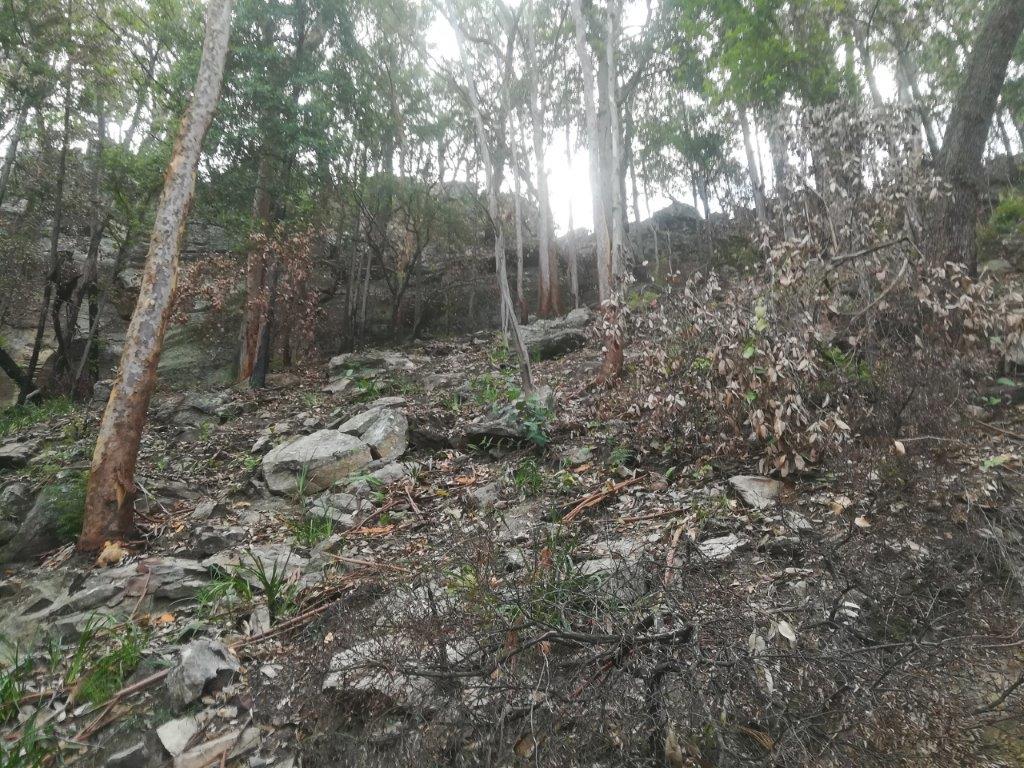
Yuslan Descend
Is a way of means to descend the eastern side from the mid section of Korrowall Ridge at Point Repulse. A cairn just below the end of Point Repulse is the starting point of the means of descent on the eastern side down towards the 4WD track that leads to Kedumba Crossing. It involves a short scramble down the ridge, followed by a direct descent through an open and steep slope. It meets the 4WD track below where it bends very sharply. Named by Alan Chan after Alan and Yusrin Mulia on a bushwalk 13 January 2019.
Zeus Minor
A small pagoda studded ridge, is a western branch of Zeus Ridge.The end pagoda contains a slot referred to as Alcibiades Rift. So named on a Bush Club walk, 25th July 2011, by Michael Keats.
Zeus Ridge
Is a north south trending ridge on the eastern side of Moffitts Trail and west of Poseidon Arena. Named by Michael Keats and Brian Fox on a Bush Club Walk, 16th April 2010. The Greek god Zeus had two brothers, Poseidon and Hades. Three ridges trending north south and parallel to each other are each given one of these names. This area has spectacular views and pagodas.
Zig Zag Historical Railway
From 1910 to 1975, the upper levels of the Zig Zag lay abandoned. In 1972, a group of railway enthusiasts formed a co-operative and started to rebuild the track and buy rolling stock. Steam trains began to run again in 1975 on the middle road only. In 1986-7, with the aid of a NSW Bicentennial Grant, the track was extended along the top road to Clarence, opening in 1988. Tourist trains ran each day of the year (except Christmas Day) until it closed in June 2012. This tourist venture was all set to re open in late 2013, but due to bush fires extensively burning infrastructure in late October 2013, the reopening has been put on hold. Additional named features within and surrounding this historical complex, are Mount Sinai Halt, Edgecombe, Whistle, Top Points, Bottom Points and Rosegardens. Also see The Great Zig Zag.
Zig Zag Spur
Trends in a generally southern direction off Waratah Ridge 800m east of the road barrier and the boundary between Newnes State Forest and Blue Mountains National Park. This spur is on the eastern side of Stillson Spur and is one kilometre in length. So named by Michael Keats on a Bush Club walk, 20thJuly 2012, due to the zig zag line of the spur in the southern portion.
Zobels Gully *
is about 1.2km long and flows into Wolgan River approximately 3km south, south east of Newnes. Its upper reaches flow through part of Constance Gorge. A northern tributary of Zobels Gully is also 1.2km in length. At the saddle of this tributary is a cairn which is a reminder to bushwalkers that this is the main walking access from the western end of Island Mountain to the Wolgan River and Newnes. Zobels Gully North GR 442 243 to 439 234. Martin Francis Zobel (1861-1935) married Sarah Jane Simpson (1876-1961) in 1899. They lived at Sunny Corner (near Bathurst), Mount Victoria, and Newnes, and later in life moved to Ashfield (Sydney). Martin was a geologist and miner. The Certificate of Title records his purchase of Lot 22, Section 33 within the Village of Newnes in 1909. This title records his occupation as Mine Manager. Lot 21 was purchased in his wife's name. One of the unformed roads in village of Newnes was named Zobel Street. Plan of Portion 2, Mineral Lease 12, Parish of Glen Alice and Gindantherie, records, "Martin Zobel, Agent for Commonwealth Oil Corporation Ltd 12th July 1907." Ref: NSW BDMs. Rego. No. 9008/1899. Vol. 2118; Fol. 211. Funeral Notice, SMH, 4th April 1935, p. 9.
Zobels Ledge
Is located on the eastern side below the top cliff line within Zobels Gully. The northern access starts from the northern tributary and from the natural spring in the overhang in Zobels Gully. It traverses in a southerly direction for about 1 km, where a small gully gives access to the valley floor. Named by Yuri Bolotin and Brian Fox on a Bush Club walk 25th November 2016.
Zobels Point
Is the southernmost extremity of Zobels Spur. Located above the northern side of Zobels Gully, and directly opposite Constance Point. Extensive views up the Wolgan Valley towards Donkey Mountain. Name coined by Michael Keats on a Bush Club walk, 6th November 2011.
Zobels Spur
is 700m in length and has a narrowing spur line. It islocated on the northern side of Zobels Gully and above the Wolgan River. Openwoodland is replaced by a pagoda studded spur, giving extensive views andhaving Zobels Point at its southernmost extremity. Name coined by Brian Fox ona Bush Club walk, 6th November 2011. Mount Morgan Topo Map, GR 440240.
Zorro Canyon
This canyon is located between Carne Creek and Adrenalin Creek. Access via Sunnyside Ridge Road. 1.2kn north of the Gardens of Stone National Park boundary.
Zorro Pass
Is located on the eastern side of the headland on the same fire trail that leads to Zorro Canyon. It has a natural configuration similar to the letter "Z" and it is also located 700m north east from Zorro Canyon. Named by Michael Keats during a Bush Club walk, 22nd May 2014.
